
9 minute read
The Preparation of an Aluminum Complex Grease
The Preparation of an Aluminum Complex Grease Formulated with PAO 6 AND mPAO 65
Paul A. Bessette* and Ken Hope** *Triboscience & Engineering, Inc., Fall River, MA 02720 **Chevron Phillips Chemical Co., LP, The Woodlands, TX 77380 Presented at the 85th Annual Meeting June 9-12, 2018, Coeur D’Alene, ID
Abstract
This paper provides a simple example of the use of mPAO 65 (metallocene polyalphaolefin oil, kinematic viscosity = 65 cSt at 100°C), PAO 6 (1-decene based, kinematic viscosity = 6 cSt at 100°C) and an aluminum-based thickener to produce an aluminum complex grease. The grease was formulated using an aluminum source that did not liberate isopropyl alcohol. Excellent properties are highlighted, although the grease was not formulated for a particular purpose but rather as an example of using PAO and mPAO in an aluminum complex grease.
Introduction
In the two previous papers in this series, the focus has been on the use of mPAO in lithium soap [1] and polyurea greases [2]. In this paper, the focus is on the usage of mPAO 65 (65 cSt at 100°C) and PAO 6 (1-decene-based, kinematic viscosity = 6 cSt at 100°C) in an aluminum complex grease. Aluminum complex greases were first invented by Bruce Hotten of the California Research Corporation in 1952 [3]. That patent described the improved melting point and water emulsification resistance of a so-called ‘di-soap’ grease. Di-soap greases are now termed complex greases since they contain more than one organic or oleophilic anions, which are typically benzoic and stearic acids. Aluminum complex greases began to appear in a commercial sense in the mid-1960s [4,5] and have found use in (and are considered as) multi-functional and multi-purpose greases. Their relatively low soap and high oil content allow for good low temperature pumpability and good stability toward mechanical shear. In addition, these greases typically have excellent heat reversion characteristics so that the consistency of the grease is regained after heating under static or low shear conditions.
Purpose
The purpose of this work was to demonstrate the viability of using mPAO 65 as a high viscosity blending component to formulate aluminum complex grease. The grease was formulated to contain 7.5% (by weight) aluminum-based thickener produced using an aluminum source that does not liberate isopropyl alcohol. The finished grease contained HX-1 additives to provide both antiwear and corrosion protection. (HX-1 additives are chemical products that are listed and registered by NSF International for use in H1 lubricants. NSF-registered H1 lubricants are acceptable as lubricants with incidental contact for use in and around food processing areas according to the US Food and Drug Administration.) The stoichiometry of the grease chemistry is discussed below along with chemical and physical properties of the finished grease. The formulation was not optimized for any particular application. The mPAO 65 was blended with PAO 6 to a viscosity of 162 cSt at 40°C.
The grease composition is shown in Table 1.
Raw Materials
Although high viscosity PAOs have been commercially available since the 1980s [6] mPAOs are relatively newer [7] with commercial grades available since 2011. The physical property advantages of the mPAO oils compared to traditional high viscosity PAOs are a higher viscosity index, lower pour point and better low temperature viscometrics. Since these mPAOs are still relatively novel for lubricant development, there are still opportunities to understand where they can or should be used to provide advantages in lubricants and greases.
Previously, a paper was presented at the NLGI annual meeting in 2016 showing the usefulness of mPAO 65 in a lithium grease [1]. In that paper, it was demonstrated that the low temperature (-54°C) torque was substantially lower than a similar grease prepared using a traditional high viscosity PAO 40 base oil. In 2017, another paper was presented at the NLGI annual meeting that highlighted the benefits of using a preformed diurea thickener with mPAO 65 as a base grease [2] .
Table 2: Properties of mPAO base oil

Grease Preparation
The thickener was prepared in all of the base oil with the exception of a small amount set aside to accommodate the additives. The particular source of the aluminum chosen does not liberate isopropyl alcohol. However, the stoichiometry of the thickener must be adjusted to account for acids present on the aluminum source.
Since PAOs have a high aniline point, the mole ratio of aluminum to acid was chosen to be 1:1.9. Table 3 provides the information pertaining to the molecular weight of the ingredients, mole ratios and unit weights.
Table 3: Stoichiometry of the grease thickener (top) and proportions, quantities used to make thickener (7.5% by weight) of 45.36 kg (100.0 lbs.) of grease, unadjusted percentages, and adjustments (see note below).
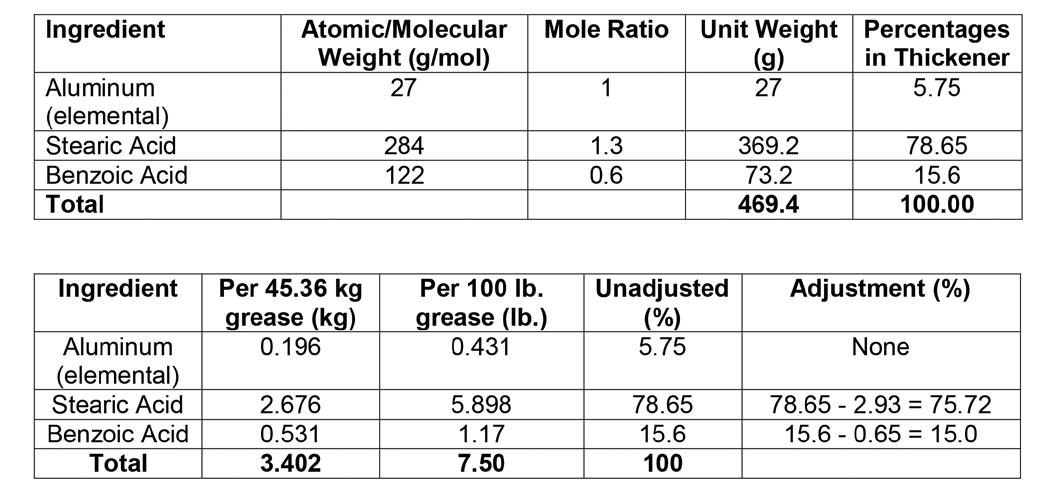
Note: Since the aluminum source contains 2.93% stearic acid and 0.65% benzoic acid, these percentages must be subtracted from the calculated amounts to maintain proper stoichiometry.
The assay of the aluminum source is 5.3% elemental aluminum. The amount of the aluminum source required to yield 45.36 kg (100.0 lb.) grease is: 0.196 kg ÷0.053 = 3.70 kg (8.16 lb.)
The approximate formula for the aluminum benzoyl stearoyl hydroxide thickener is as follows:
Al (C02R’)(CO2R”)(OH)
In the above formula, R’ refers to the stearic group, and R” refers to the benzoic group.
Experimental
All of the base oil was added to the laboratory grease vessel with the exception of a small amount necessary to dissolve the additives.
The vessel contents were then heated to 90°C and the temperature was monitored with a thermocouple.
The stearic and benzoic acids were added with constant agitation.
When both acids were completely melted, the aluminum source was added. The temperature was gradually raised to 180°C and maintained at that temperature for approximately 10 minutes.
When the batch reached 100°C, the additives were added to the vessel.
The grease was then homogenized at 6000 psi in a Gaulin homogenizer.
The vessel temperature was controlled carefully prior to adding the aluminum source and during the thickener formation reaction to prevent the sublimation of the benzoic acid.
The tests that were conducted on the finished grease are reported in Table 4.
Table 4: Physical properties of the formulated aluminum complex grease

The apparent viscosity of the grease was determined using a TA controlled stress rheometer, Model AR 1000N. Less than a gram of grease is sandwiched between a rotating spindle and a stationary base plate. Temperature is controlled using a Peltier plate to 0.1°C. The spindle is 40 mm in diameter and has a two degree angle providing constant shear. This instrument is an ideal analytical tool to study the shear thinning behavior of viscoelastic materials.
Volatility of the grease was determined using a TA Instruments Model Q50 TGA. The instrument requires milligrams of sample and measures weight loss to 0.1 mg as a function of increasing temperature. The key components of the TGA are a microbalance and a furnace. Air or nitrogen may be selected as the purge gas.
A photograph of the grease is shown in Figure 1. A Nordson EFD cartridge was used to contain the grease after ultrafiltration. These cartridges allow for vacuum centrifugation of the grease to remove entrained air introduced during the filling operation. Residual air can be problematical when filling small quantities of grease into miniature bearings. The grease shown in Figure 1 has an ideal appearance for incidental food contact applications.
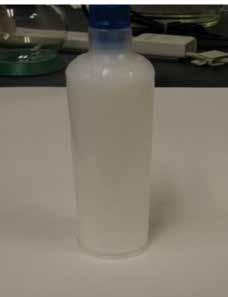
Results
Figure 2: FTIR spectra of mPAO (top) and aluminum complex grease (bottom)

Figure 2: The expansion of the region of the FTIR spectrum where the presence of the thickener is indicated by the triplet peaks at 1605, 1586 and 1568 cm-1
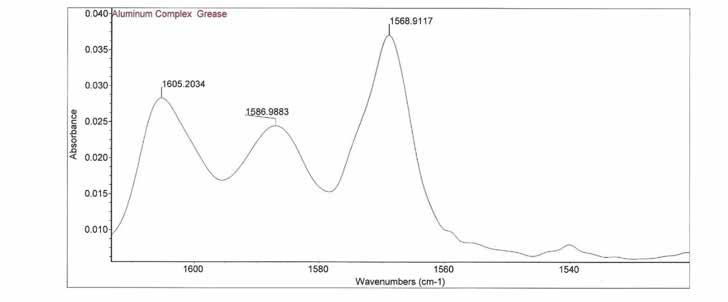
Figure 3 shows the rheological profile of the grease at shear rates from 1.9 to 25 (1/sec). The red plot shows shear stress while the blue plot is apparent viscosity, both as functions of shear rate.
Figure 3: Rheological behavior of the grease as a function of shear rate
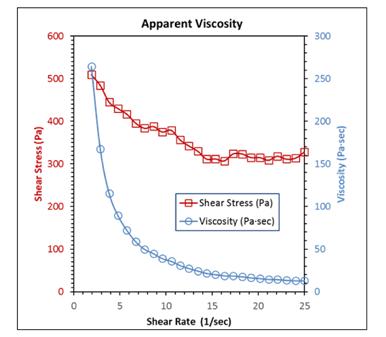
The smooth appearance of each curve in Figure 3 is noteworthy. This behavior is usually encountered when the thickener is in a well-dispersed state.
Figure 4 is a plot of the apparent viscosity of the grease as a function of decreasing temperature. The data were generated using a Brookfield Viscometer attached to a Tenney environmental chamber. The data were generated using a T-C spindle operated at 1 RPM. Apparent viscosity data were recorded at 5-min intervals using a computer program that monitored both temperature and apparent viscosity. The recorded apparent viscosity at -40ºC was 6.5 million mPa.s.
Conclusions
• A successful aluminum complex grease was prepared using mPAO 65 as the high viscosity oil blending component. • The aluminum source released no IPA in the grease preparation. This was accomplished by carefully adjusting the thickener stoichiometry. • Using 7.5% thickener resulted in an NLGI Grade 1 grease. • The grease exhibited good antiwear performance in a four-ball wear test, a dropping point above 260ºC and excellent thermal oxidative stability at 150ºC. • After 24 hours at 100ºC, copper coupon corrosion testing resulted in a freshly polished appearance. • This grease was not optimized for any one particular application. However, all the ingredients used were HX-1 approved for use in food grade greases. • mPAO 65 continues to demonstrate its usefulness as viable base oil component to make greases prepared with lithium complex, polyurea, and aluminum complex thickeners.
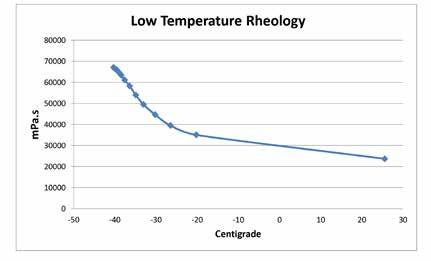
References
[1] Bessette P. and Hope K. “Synthetic Grease Formulated Using PAO 6 and mPAO 65”, NLGI Annual Meeting, Hot Springs, VA, June 12, 2016. [2] Bessette P. and Hope K. “The Preparation of a Polyurea Grease Using mPAO 65 and Preformed Diurea”, NLGI Annual Meeting, Olympic Valley, CA, June 13, 2017. [3] Hotten, B. W. “Complex Aluminum Soap”, U.S. Patent 2,599,553, 1952. [4] LE-International Techni/Tips #89. http://www.le-international.com/pdf/089-aluminum-complex-grease.pdf [5] Kruschwitz, H., Thickener Systems for Aluminum Complex Grease, NLGI Grease Education Course, 1993. [6] Rudnick L. R. “Synthetics, Mineral Oils, and Bio-Based Lubricants Chemistry and Technology”, CRC Press, Taylor & Francis Group, Second Edition, page 4, 2013. [7] Hope K., “Polyalphaolefin Lubricant Applications” ASM Handbook, Vol 18, Friction, Lubrication, and Wear Technology, George Totten editor, page 207, 2018.
Acknowledgements
• Chevron Phillips Chemical Company LP for sponsoring this work. • Mr. Chris Horvath, Fed Chem, Inc., for graciously supplying the aluminum source to complete this project. • Dr. Maureen Hunter, King Industries, Inc., for providing a complimentary sample of a multifunctional additive package • The late Hank Kruschwitz, an indefatigable promoter of aluminum complex technology and wonderful personal friend.



